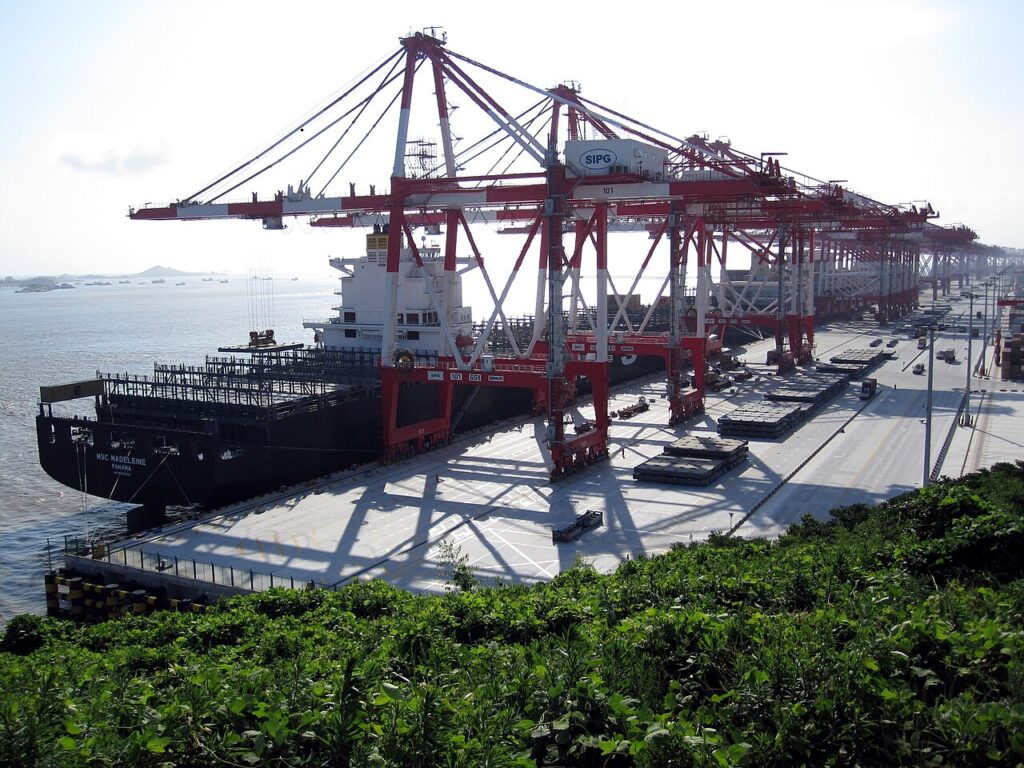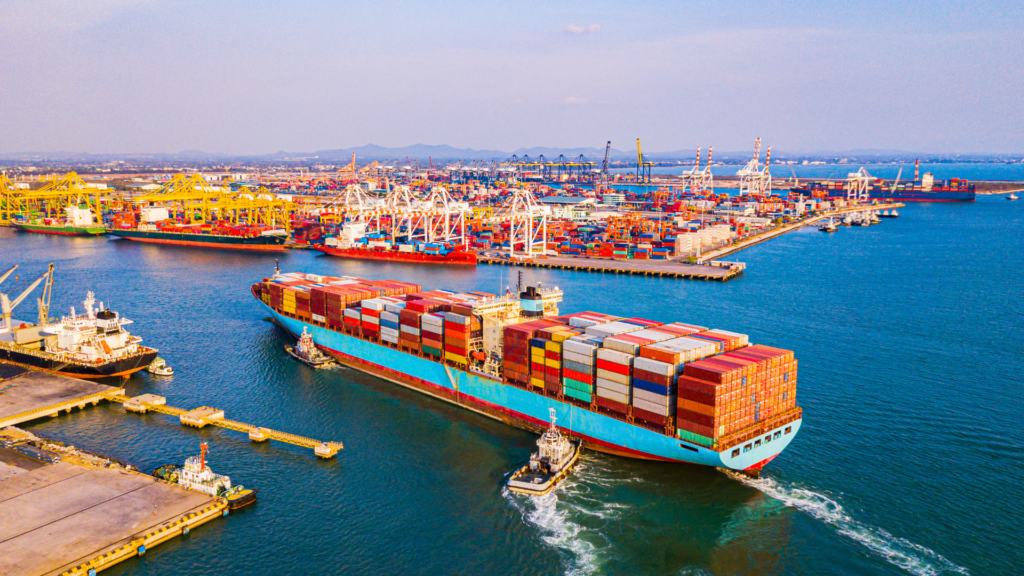Ports of the Future
As the link between land and sea, ports play a critical role in decarbonisation.
Ports have been centres of trade and cultural exchange for millennia, with the oldest known ports dating back over 4,500 years. Over their long history, ports have evolved to adapt to our changing use of the sea, playing a central role in our increasingly interconnected economy. Their influence extends far beyond their coastal locations. We need only think about the fact that anyone reading this is doing so from a screen that is made up of hundreds of parts from across the globe and brought to a retailer near you via various ports of call along the way.
Over their long history, ports have evolved to adapt to our changing use of the sea, playing a central role in our increasingly interconnected economy.
Ports have grown substantially to meet the rising demand for global shipping and today enable the transport of over 80% of the goods traded worldwide. Shanghai, the world’s largest port and busiest shipping port, is over 3,600 square kilometres in size – processed a record breaking annual container throughput of 50 million TEU (Twenty-foot Equivalent Unit – the average size of a shipping container) in 2024.

With decarbonisation high on the maritime agenda for 2050, ports are evolving again, turning towards digitalisation, automation, and data-driven insights to optimise port processes, reducing inefficiencies and cutting down waiting times, with cascading benefits for both sides of the global supply chain.
Ports of the future, today
Industry 4.0 is transforming industries across the board. As of 2025, the “smartest” ports are taking full advantage of advances in the Internet of Things (IoT), AI, automation, and blockchain technologies to unlock opportunitiesthat optimise port operations. With these tools, ports can provide more reliable schedules, faster turnaround times, and improved worker safety, making them more attractive ports of call for any route planner.
What is a fully automated port?
In a fully automated port, the stacking yard cranes and horizontal transport between the quay and the yard are all automated. Semi-automated ports rely on automation for yard cranes, and human-operated horizontal transfers around the port.
Since the Port of Rotterdam introduced the world’s first fully automated port terminal in 1993, automation has had an increasingly relevant role. While the uptake of automation has been slower than in other sectors, as of 2024 there are over 70 automated container terminals, 22 of which are fully automated. And more ports of the future are on their way: the two busiest container ports in the world, Shanghai and Singapore, are heavily investing in automation. Singapore opened Tuas Port in 2022 – expected to be fully operational by 2040 – and it aims to be the world’s biggest fully automated port, employing automated yard cranes as well as automated guided vehicles for horizontal transport. In May 2025, the Port of Shanghai announced the construction of its largest automated container terminal for 2033.
The sector is similarly taking advantage of digital twins – virtual representations of ports that use real-time data – which are being tested and used worldwide at some of the busiest ports. From a logistical point of view, the benefits of a digital twin are unparalleled. Real-time data from sensors about equipment, cargo, and port conditions combined with satellite imagery, traffic, and weather data, equip ports with all the information they need to ensure the best allocation of resources. This supports cargo tracking, faster cargo handling, and enables predictive maintenance, lowering the risk of worker injury and strengthening risk planning.
These trends, together with additional opportunities from integrating AI, blockchain technologies, and innovative data-sharing practices and technologies, such as those developed by the EU-funded MISSION project, are providing actionable data-driven insights that enable the highest degree of optimisation in all port activities. And with it, the opportunity for port call optimisation.
Unlocking the full potential: Port Call Optimisation
In 2024, the Global Liner Performance Report from Sea Intelligence found average schedule reliability to be between 50 and 55%: half of the time, ships experienced delays. Another study found that ships could spend an average of 15 to 22 days per year waiting for a berth or services, amounting to 4-6% of operational time per year. The potential emissions savings from addressing waiting time could be huge: 10% for container ships and bulkers; 16% for gas and oil tankers; and almost 25% for chemical tankers.
The potential emissions savings from addressing waiting time could be huge: 10% for container ships and bulkers; 16% for gas and oil tankers; and almost 25% for chemical tankers.
What is a port call and what is port call optimisation?
Port call refers to all the activities involved in the scheduled stop of a ship at port, from arrival to departure, including berth allocation, pilotage, cargo operations (loading and/or unloading), bunkering (refuelling), compliance inspections, crew changes, waste disposal, maintenance, and any other services agreed with the port or terminal.
Port Call Optimisation is the process of improving the planning and execution of a ship’s port call so that its arrival is coordinated with the availability of nautical services. Benefits include fuel and emissions savings, operational efficiency and cost savings, higher predictability and coordination, and improved safety and environmental quality.
Just-In-Time shipping is a shipping practice enabled by Port Call Optimisation, referring to a model in which a ship’s arrival is coordinated with the availability of berth and services.
Port Call Optimisation proposes a model in which a vessel’s arrival time is coordinated with the availability of services and berths. In practice, this means that any delays are communicated as early as possible, and ships can adjust their speed to arrive when a berth is available. This reduces congestion in and around the port and permits the ship to optimise the journey for fuel consumption.
Key terms to follow along:
Demurrage: A fee paid by the charterer, (i.e. the party responsible for loading and unloading the cargo) to the shipowner if cargo operations exceed the agreed laytime (the time allowed in the charter party for cargo operations). It compensates the shipowner for delays in making the ship available for its next employment.
Despatch: The inverse of demurrage, despatch is a payment made by the shipowner to the charterer when cargo operations are completed in less than the laytime specified in the charter party.
Notice of Readiness: A formal notification issued by the ship’s master (or their agent) to the charterer, confirming that the vessel has arrived at the agreed location (port area, anchorage, or berth, depending on the charter terms), is in all respects fully ready to load or offload cargo, and has the required documentation in order. Tendering the NOR marks the start of laytime.
For this approach to work, each stakeholder group’s respective sets of obligations and incentives need to be considered and realigned to allow for emissions reduction opportunities to be taken – a long-winded way of saying we need to make sure that there is something in it for everyone.
For ports, the argument is clear. As direct beneficiaries of Port Call Optimisation, this group stands to gain significantly. For charterers, optimised port processes can lead to tighter scheduling, reducing demurrage fees, and potentially earning dispatch payment instead.
For shipowners and shipmasters, it is not quite so straightforward. The industry standard practice at port has long gone by the principles of “first come, first served,” encouraging ships to “sail fast then wait”. Port Call Optimisation challenges this status quo, asking them to slow down and arrive at a more convenient time for the port. While this can reduce fuel consumption and waiting times, contractual terms such as demurrage complicate the incentives.
Port Call Optimisation challenges this status quo, asking them to slow down and arrive at a more convenient time for the port.
Demurrage, paid by the charterer to the shipowner when cargo operations exceed the agreed laytime, can influence the behaviour of shipowners and masters. Laytime usually starts when the Notice of Readiness is tendered, not at arrival, so any time waiting before NOR does not count as lost time for the shipowner. Once NOR has been tendered, laytime is considered to have started, so any subsequent port delays, such as congestion or berth unavailability, are typically borne by the cargo interests. Depending on the charter party terms this could include shippers, receivers, charters, or insurers.
This nuance can reduce the incentive for shipmasters to adjust speed for port convenience. For shipmasters, the vessel’s operation is their responsibility, but unless the contract includes specific incentives, such as performance bonuses or shared fuel savings, there is little reason to slow down for optimisation.

Enter virtual reality. Well, Virtual Arrival (VA). The Virtual Notice of Readiness (VNoR) was first introduced in 2011 and allows a vessel in transit to register its arrival as the time it would have arrived, had it sailed at full speed. A nifty fix, this contractual mechanism means that if a delay is communicated by the port with enough notice, the shipmaster can optimise the ship’s speed for fuel efficiency and arrive at an updated agreed-upon time while still registering their “contractual arrival” as when they would have arrived travelling at “utmost despatch” – the nautical phrase for “as fast as you can.”
By decoupling contractual arrival from actual sailing speed, VNoR allows the benefits of Port Call Optimisation without the need for a full overhaul of contracts or sector-wide collaboration, as it requires just two parties to agree to it: shipowners and charters. In doing so, VNoR better aligns shipowners’ incentives with port efficiency goals, creating a clearer motivation to slow down when it benefits the overall supply chain. Compared to full-blown Just-In-Time shipping, which a joint article from International Taskforce Port Call Optimisation (ITPCO) and BIMCO (one of the largest associations representing shipowners) describes as “a multilateral agreement between all stakeholders involved in a port call,” VA is somewhat easier to implement.
VA pilot testing has demonstrated fuel consumption savings, but a 2025 report from the Global Maritime Forum highlights that a lack of coordination across the supply chain has hindered large-scale implementation. Regardless of how clever a solution it may be, its impact could remain minimal unless adoption rates increase.
Influencing the sector from the land out
Ports are central by design: their locations chosen precisely because they were the perfect place to connect land and sea, providing ability to connect people across vast distances. Today, they are central hubs that underpin the functioning of our global economy, connecting stakeholders from across the globe. In their brief on Port Call Optimisation, the Global Maritime Forum suggests that ports are also perfectly placed to assume a more proactive role: by requiring the use of VA in their contracts, ports can drive up adoption rates, helping to create the conditions they need for ships to engage in port call optimisation processes.
Ports continue to evolve, influenced by rising shipping demands, decarbonisation goals, and the opportunities offered by advanced digital technologies. But if the Global Maritime Forum is right, maybe this time ports have the chance to leverage their central position, literally and figuratively, to influence the parallel evolution of the maritime sector, and in doing so, unlock benefits for the sector and beyond.